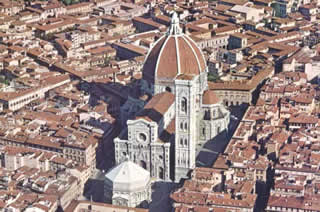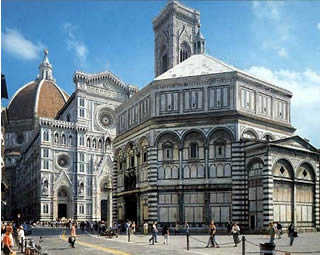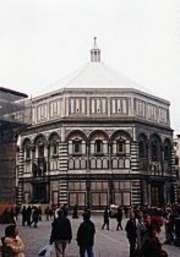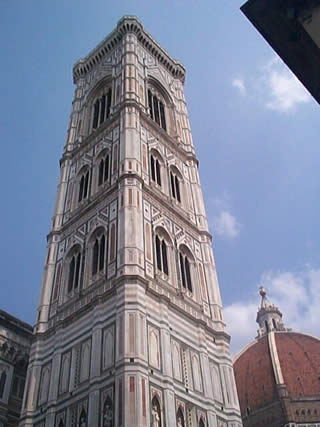Firenze - Santa Maria del Fiore
Chiesa di S.Maria del Fiore (Duomo)

The construction of the Duomo, the Cathedral also called Santa Maria del Fiore, was started by Arnolfo di Cambio on the 8th September 1296. It is the & fourth longest church in the world (after Saint Peter in Rome, Saint Paul in London and the Cathedral in Milan). In some experts' opinion, Arnolfo's project was quite different from the present building, but the outside walls undoubtedly are the same as those in the original plan. When Arnolfo died in 1310, there was a delay in the works.
They however were started again in 1331, when the Guild of Wool Merchants took over the construction of the church. In 1334 Giotto was appointed 'capomastro' of the works. He mainly attended to the building of the campanile and died three years later. There were several interruptions until 1367, when a competition was held and a final model for the church by four architects and four painters was accepted. The vault of the nave was finished in 1378 and the aisles were completed in 1380. Between this year and 1421 the tribunes and probably the drum of the dome were built. The octagonal dome, consisting of two concentric shells linked together, was completed in 1434. A competition was held for the dome in 1418 and, after many doubts, Filippo Brunelleschi's project was accepted in 1420.

The church, dedicated to Santa Maria del Fiore (fiore referring to Florence) was consecrated on the 25 of March, 1436. The remarkable differences in the various parts of the Cathedral show the evident changes in taste during the long time passed between the foundation of the church and its completion. Outside the shape of the round blind arches is a Romanesque vestige. The whole interior, with its huge arches, doors and windows, is Gothic . The dome is a masterpiece of the Renaissance.
Battistero
Florence's Battistero di San Giovanni was built in the VII century, probably following the conversion of Queen Teodolinda to Christianity. The building, which is octagonal and is faced with white and green marble (the latter from Prato), was erected on the site of a sumptuous Roman structure, possibly a Domus, using a considerable quantity of marble from Roman ruins. Both the Baptistery and Santa Reparata (Florence's cathedral) were outside the Carolingian walls, but were included within the Matildine walls. This inclusion proved both a boon and a bane; the Baptistery was soon surrounded by houses that pressed in upon it from all sides, and was only released from this siege in the XIV century. That square was expanded further, putting the Baptistery at the center of a geometric space, in the XV century.

The Baptistery proper reached its present form between the XI and XIII centuries, and the doors are extraordinary masterpieces. The Southern Door has bas-reliefs by Andrea Pisano. The northern door, also known as the Porta della Croce (The Door of the Cross) has Lorenzo Ghiberti's scenes from the Life of Christ. The Eastern Door, called La Porta del Paradiso (The Gates of Paradise) by Michelangelo, has Ghiberti's great masterpiece, scenes from the Old Testament. The Guild that commissioned the work in 1425 told the artist to spare neither time nor expense, and left the choice of subject matter up to him. In working on the panels, Ghiberti was assisted by his sons, and also by Michelozzo and Benozzo Gozzoli. The inside of the Baptistery has an octagonal cupola with Byzantine mosaics; the walls instead are faced with marble. The funerary monument to the Antipope John XXIII is by Donatello and Michelangelo.
Belfry by Giotto

The belfry of "Santa Maria del Fiore" is one of the most brilliant artistic works and symbol of the city of Florence, a genius and really grandiose idea of Giotto, created more as a decorative monument rather than as a functional one.
In 1334 after Christ, after a slow down in the works of the new Cathedral that lasted more than thirty years, Giotto becomes the responsible of the works and decides to project again an original belfry. In order to achieve this new element decorating the square, the maestro works from 1334 after Christ to 1337 after Christ, year of his death, seeing realised only the first zone, where the cuspidal entrance opens itself. His painting experience leads him to decide upon an external decorative coating that proceeds in parallel with the structural building, everything obviously at the cost of the realisation speed. White marbles of Carrara, red of Siena and green of Prato freshen the forms, and subdivide them with a classical severity, while on all the sides appear the painting cycles through a succession of little octagonal forms with relief painted by Andrea Pisano on designs which were in part the work of the hand of the same Giotto.
Andrea Pisano himself substitutes Giotto the year when he dies and at his time, he is substituted, in 1348 after Christ, by Francesco Talenti who, with some modifications on the original project, concludes the works in '59.
The architecture of the belfry, slight and refined (84,70 metres for 14,45), has a square map and is supported at the corners by buttresses with the form of pillars that reaches the top.
Both series of little forms with low relief of the first piano (representing the allegories of the work, the symbolic figures of the celestas bodies, of the Virtues, of the liberal arts and of the Sacraments), and the sixteen statues of the second piano have been substituted by copes. The original works are actually preserved in the "Museo dell'Opera del Duomo" (Museum of the Work of the Cathedral); among these statues we find the magnificent ones of Nanni di Bartolo and Donatello such as the famous Abacuc.
The last three foregrounds of the Belfry of Giotto are the fruit of the genius of Francesco Talenti. In these plans we find large vertical windows with double "bifora" in the third and fourth plan and of only one "trifora" in the fifth, which gives a certain refine sensation, without any sense of heaviness, typical of the gothic. This is also due to the happy intuition of Talenti: a terrace with large dimensions appreciably projected towards the outside, in alternative to the normal cusp of the gothic belfries. A design preserved in Siena, well illustrated as the final part of the monument should have been, certainly less innovative and original, without the intervention of Talenti.